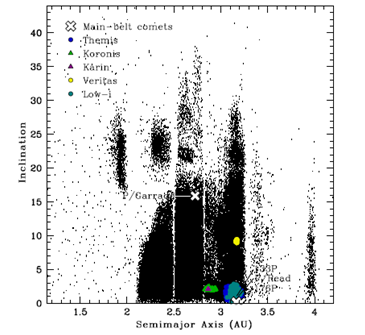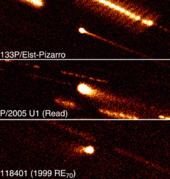In 1996, astronomers identified an extraordinary object orbiting the Sun between Mars and Jupiter in a region best known for its asteroids. And yet this body, called 133P, defied description: it had the orbit of an asteroid yet emitted dust like a comet.
Clearly, this was a rare object. After centuries of observation, not a single other object in the asteroid belt had burped gas and dust in the same way.
So how could this have got there? According to Henry Hsieh at Queen's University, Belfast in Northern Ireland, there can be only two explanations. The first is that 133P is a comet that has somehow recently become trapped in an asteroid-like orbit. This would have required a hugely unlikely combination of gravitational kicks from other planets as the comet travelled into the solar system from the Kuiper Belt or Oort cloud.
Hsieh says this is so fantastically unlikely that it is almost certainly a one-off event. So there's almost no chance that we'd see another comet-like object in this kind of orbit.
The second explanation is that 133P is an asteroid formed partly of ice and that this is being released, perhaps by a collision with another asteroid. If this were the case, there would almost certainly be other asteroids with a similar makeup releasing dust. These we ought to be able to see.
So Hsieh set out to find one, making some 657 observations of 599 asteroids in the asteroid belt. The big news is that he has found one other object, called 176P/LINEAR, which is also emitting dust.
So it looks as if the mystery is solved. That more or less rules out the possibility that 133P is a captured comet. Instead, 133P and 176P are a new class of comet-like asteroids made up partly of ice, which is ejected whenever these objects are struck in the occasional unavoidable collision.
That's an interesting new addition to the asteroid menagerie. The only question now is what to call these beasts that are half comet and half asteroid. Comsteroids? Asteromets? Hsiehroids?
- -
Ref: arxiv.org/abs/0907.5505: The Hawaii Trails Project: Comet-Hunting in the Main Asteroid Belt:
The mysterious solar system object 133P/(7968) Elst-Pizarro is dynamically asteroidal, yet displays recurrent comet-like dust emission. Two scenarios were hypothesized to explain this unusual behavior: (1) 133P is a classical comet from the outer solar system that has evolved onto a main-belt orbit, or (2) 133P is a dynamically ordinary main-belt asteroid on which subsurface ice has recently been exposed. If (1) is correct, the expected rarity of a dynamical transition onto an asteroidal orbit implies that 133P could be alone in the main belt. In contrast, if (2) is correct, other icy main-belt objects should exist and could also exhibit cometary activity. Believing 133P to be a dynamically ordinary, yet icy main-belt asteroid, I set out to test the primary prediction of the hypothesis: that 133P-like objects should be common and could be found by an appropriately designed observational survey. I conducted just such a survey -- the Hawaii Trails Project -- of selected main-belt asteroids in a search for objects displaying cometary activity. I made 657 observations of 599 asteroids, discovering one active object now known as 176P/LINEAR, leading to the identification of the new cometary class of main-belt comets. These results suggest that there could be ~100 currently active main-belt comets among low-inclination, kilometer-scale outer belt asteroids. Physically and statistically, main-belt comet activity is consistent with initiation by meter-sized impactors. The estimated rate of impacts and sizes of resulting active sites, however, imply that 133P-sized bodies should become significantly devolatilized over Gyr timescales, suggesting that 133P, and possibly the other MBCs as well, could be secondary, or even multigenerational, fragments from recent breakup events.[Paper: The Hawaii Trails Project: Comet-Hunting in the Main Asteroid Belt [PDF]]





Reader Comments
to our Newsletter